Commander Masters Storyteller, Part 1
Last week, I talked about the vision design and set design of Commander Masters. This week and next, I'll be telling some card design stories from the set.
Avacyn, Angel of Hope

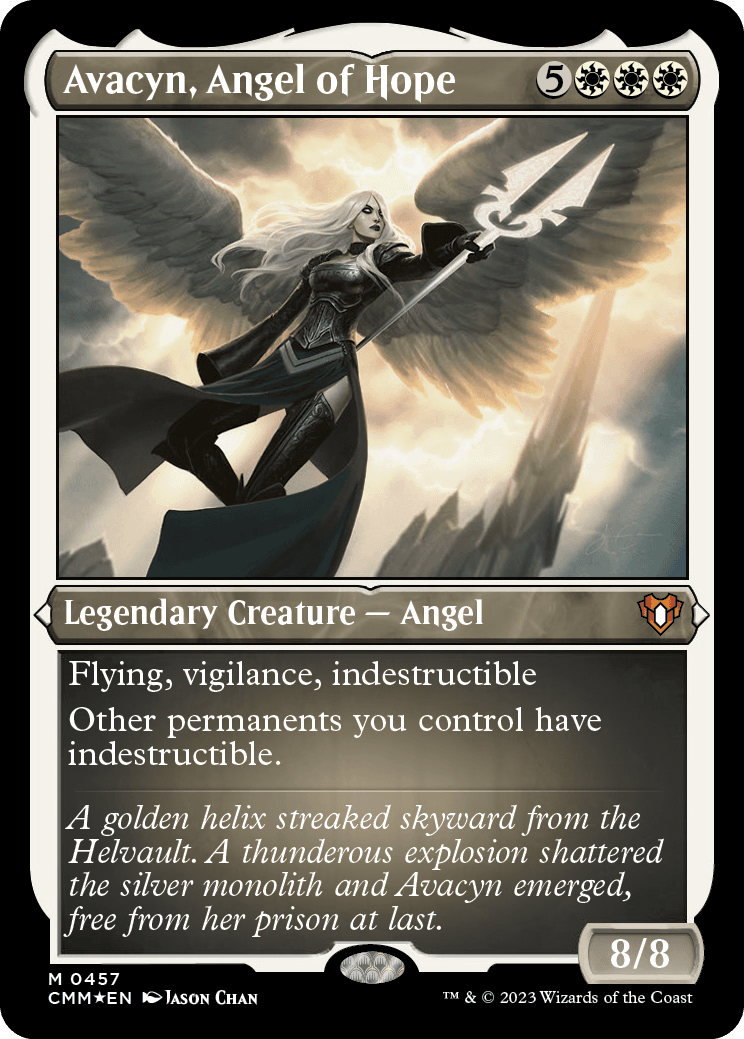
The initial plan for the original Innistrad block was to have two sets, a large and a small, that take place on one plane, share mechanics, and draft well together. The third set in the block would be large, take place on a different plane, have a new set of mechanics, and be drafted by itself. Originally, that final third set was going to take place on Innistrad. Brady Dommermuth and I had been pushing to do a top-down gothic horror set for years. Finally, Bill Rose, the VP of Magic, gave in and gave us one large set to do it in.
For the other two sets, R&D would run a company-wide contest to come up with a new plane. Tons of people submitted ideas, and the winner was a plane created by Brian Tinsman. Then, right before the fall set design was about to begin, Mark Globus brought up to Bill that it was weird to have a gothic horror set not release in October, near Halloween. Bill came to me and asked if there would be enough material to move Innistrad from May to October. I said the genre of horror was vast and popular, and we'd have plenty of material, so it was moved. The spring set would now become the plane that Brian pitched.
Brady Dommermuth, who led the Creative team at the time, didn't feel they were staffed up to design two new planes (we are now). Just as he had done with the Zendikar block two years earlier, he pitched having an event big enough to happen on the plane that justified new mechanics without having to go to a whole new plane. Brady's pitch was to have the first two sets be about the monsters attacking humans and humans being on the brink of extinction. The third set would be about something that turned things around and put the monsters on the back foot.
That something would end up being the Archangel Avacyn. Sorin had created her to keep the humans alive so that the vampires wouldn't lose their food source. Avacyn had been tricked by the demon Griselbrand and trapped in something called the Helvault. The events of the block ended up forcing Thalia to open the Helvault, releasing both Griselbrand and Avacyn. It's Avacyn being freed (restored) that sets everything in motion.
This meant that the card design for Avacyn had to be something spectacular. It was the linchpin of the whole set, so much so that her name was in it. Here's what we knew she had to be:
- An Angel
- A mythic rare
- A creature with a high mana value
- A creature with flying and vigilance
- A savior
Here was my first pitch:
Avacyn
4WWW
Legendary Creature — Angel
7/7
Flying, vigilance, trample
Prevent all damage dealt to CARDNAME and any other creature you control.
She's daunting, protects your stuff, and can single-handedly win the game. I thought it was a great design. Brian Tinsman, who was the lead designer of the set, wanted to explore other options. The big mechanic we were playing with in design was called forbidden. Forbidden cards couldn't be put into your deck. You had to play specific cards that shuffled them in. Because there was such a large hoop to jump through, we could under-cost the cards. For example, we thought we might be able to make a forbidden version of
We went through many iterations of Avacyn designs that used forbidden. Little by little, she started becoming less defensive in flavor and more offensive. She began boosting your team and made Angel creature tokens. Eventually, development put their foot down on the forbidden mechanic and we removed it from design. (It was one of the things that influenced the design of Lessons and learn in Strixhaven: School of Mages.) The next batch of designs saw Avacyn getting even more aggressive, with such abilities as destroying other creatures.
I felt we were moving in the wrong direction. To me, Avacyn was supposed to represent the opposite of the monsters. Instead of destruction, she should represent salvation. If she acted too much like the monsters, I felt like the theme of the set would be darker than we wanted. So, I pitched we go back to my very first design. We did make one major change: instead of preventing the damage, we made her have and grant indestructible. We felt that it played similarly and just read a lot more exciting.
Development fiddled with her mana value, power, and toughness (and removed trample) but otherwise kept the design as we'd turned it in.
Body Double
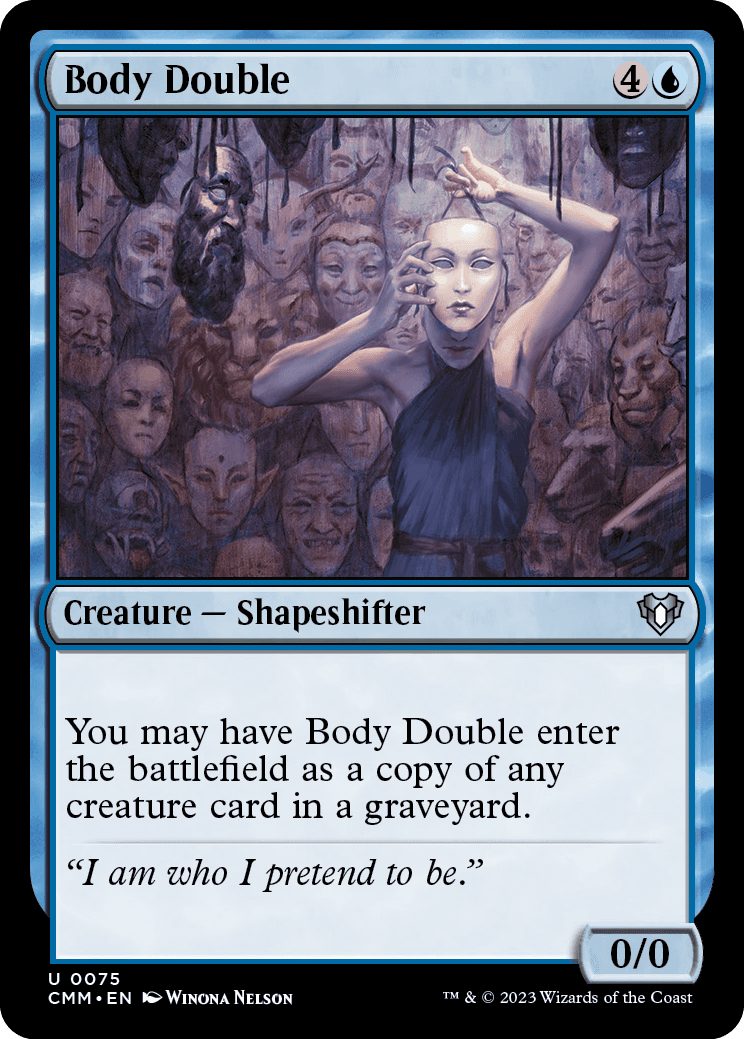
To become a good game designer, you need to enjoy playing games, so it shouldn't come as a surprise that game designers like to make little games out of designing.
The classic example of this is a green creature with the following text:
Surprise Snake
1G
Creature — Snake
1/1
Flash
Deathtouch
When CARDNAME enters the battlefield, it fights target creature.
Green is secondary in both flash and deathtouch and primary in fight, but one of its weaknesses is that it's bad at pinpoint creature destruction. If green wants to destroy an opponent's creature, it must use its own creature to do that. Technically, this spell does that but in a way that grants green a spell that is too much like a black creature kill spell. For example, if you had an empty board, you could use this spell to kill any one creature on the battlefield. That shouldn't be something green can do. What this means is even though the card can technically be assembled in color pie, the totality of it is out of color pie and thus isn't something we should print.
Nonetheless, it's fun to design cards that allow one color to mimic another color's abilities. We don't often print them, but we do design them for fun.
Then came Planar Chaos, the middle set in the Time Spiral block. The block had a past, present, and future theme. Past and future were obvious themes, but I struggled a bit with what "present" meant as a theme. Wasn't almost every expansion set in the present? Eventually, I came up with the idea of an "alternate reality present" where we could see Magic if it had made different choices. We redid the color pie and leaned into the weirdness this little game played into.
This made Planar Chaos a home for cards that dipped into the mechanical spaces of other colors. I finally had a set for
Chainer, Dementia Master
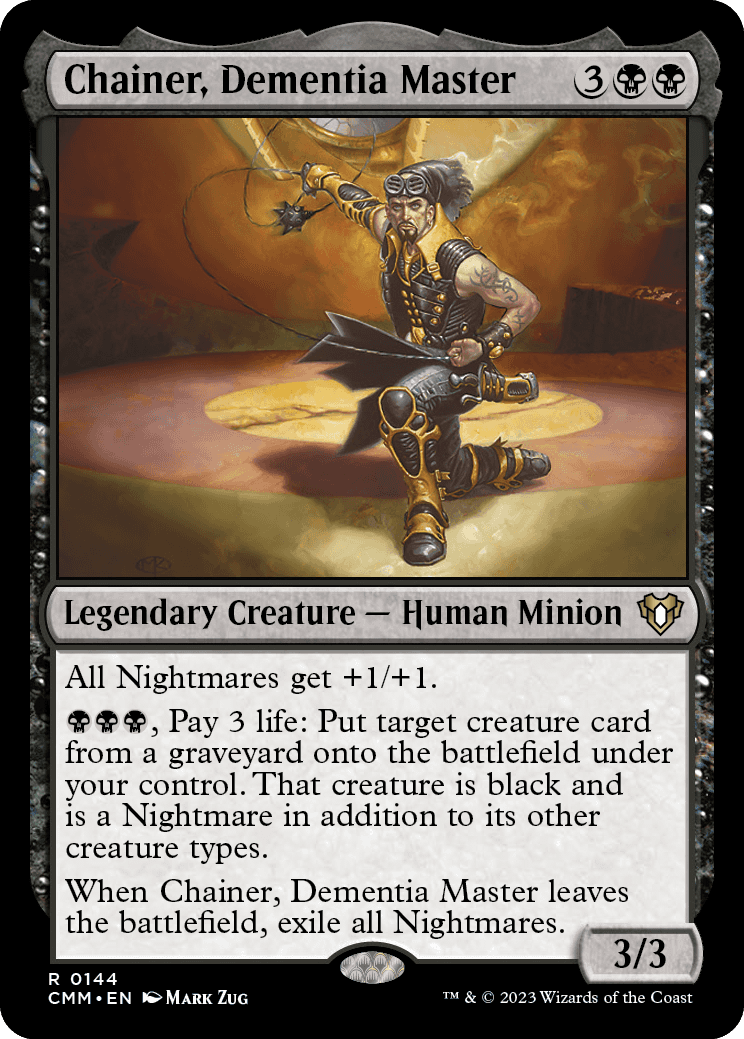
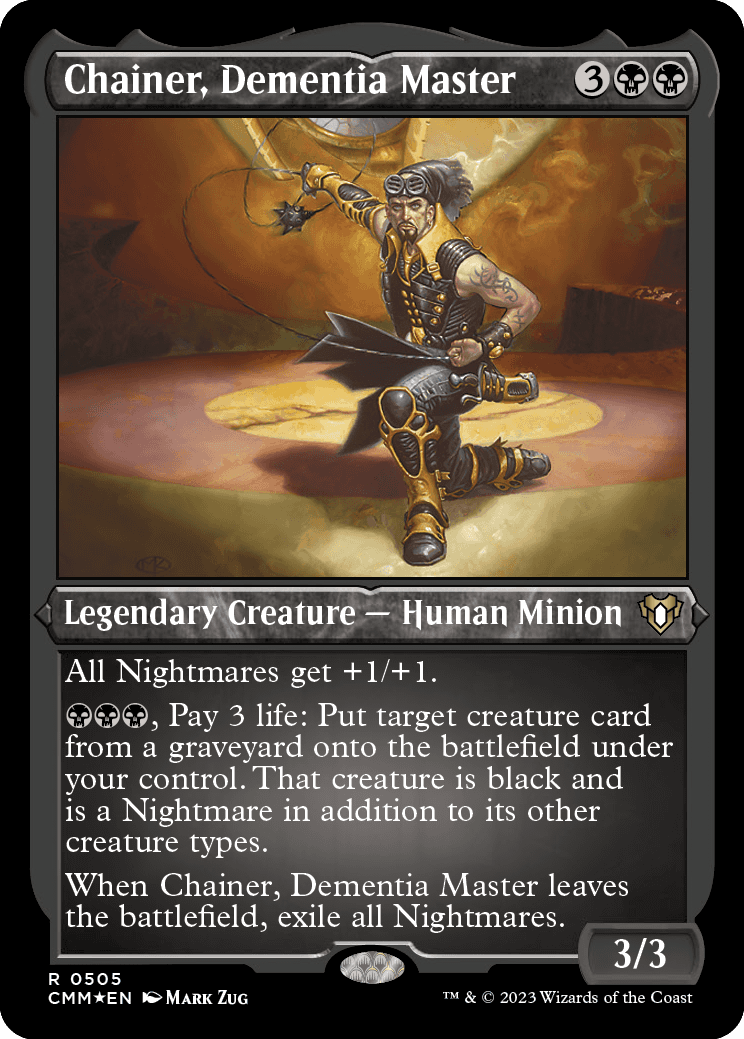
At the time that this card was designed (in Torment, part of the Odyssey block), the story was told in novels written by freelance writers. During design, we'd get a simple outline of what the story would be as it hadn't been written yet. Chainer was a character scheduled to appear in the book Odyssey, which told the story of the set Odyssey, and was planned to be the protagonist in the second book Chainer's Torment. Because we knew he was going to be the main character in the second book, we saved his card,
Chainer was what was known as a dementia summoner, meaning he had the power to pull literal nightmares into reality. Okay, how exactly does a card convey that mechanically? We knew we wanted him to create Nightmares. Maybe they could be creature tokens? At the time creature tokens were mostly vanilla creatures (flying was the only keyword we regularly used on creature tokens), so it didn't quite feel scary enough.
We then explored the idea that he could get creature cards onto the battlefield and grant them the Nightmare creature type. This was a mono-black card, so there was only one option to move cards from a zone onto the battlefield—reanimation. We made it cost a bunch of black mana, as it felt particularly black, and then added in a life payment because it captured the personal cost of dementia summoning. Next, to balance the card, we made it such that the Nightmares would leave play if Chainer did. This would allow the opponent to have an answer to all the Nightmares. We ended up making it exile, so a second copy of Chainer couldn't bring back the same creatures.
Interestingly, the ability that caused all the conversation was the first one on the card, granting +1/+1 to all Nightmares. (This was at a point in design where typal designs affected all creatures of that type, not just the ones you control.) One of the mechanics in the set, which was unnamed on the cards, was dubbed the nightmare mechanic in all our marketing. In Torment, it went on black and red creatures, all of which were creature type Nightmare. The black Nightmares removed something of the opponent's (a creature, cards in hand, life, etc.) until it left the battlefield. The red Nightmares removed something of yours but were cheaper.
At the time, our policy was to not put set mechanics on legendary creatures. Remember, this is before Commander existed as a format and legendary creatures were significantly smaller in number. There was worry that referencing Nightmares was breaking our rule. There were many conversations about whether an unnamed mechanic even counted as a mechanic for this rule. (It was deemed that it did.) It turned out that referencing Nightmares was the only way to make the last ability work, so the card had to do it. Once we realized that, we decided that it was okay to reference it twice on the card if we were already doing it once. Eventually, we would make the realization that legendary creatures wanted the set mechanics where appropriate as it helped make them feel more tied to the set and allowed players more access to them.
Fact or Fiction
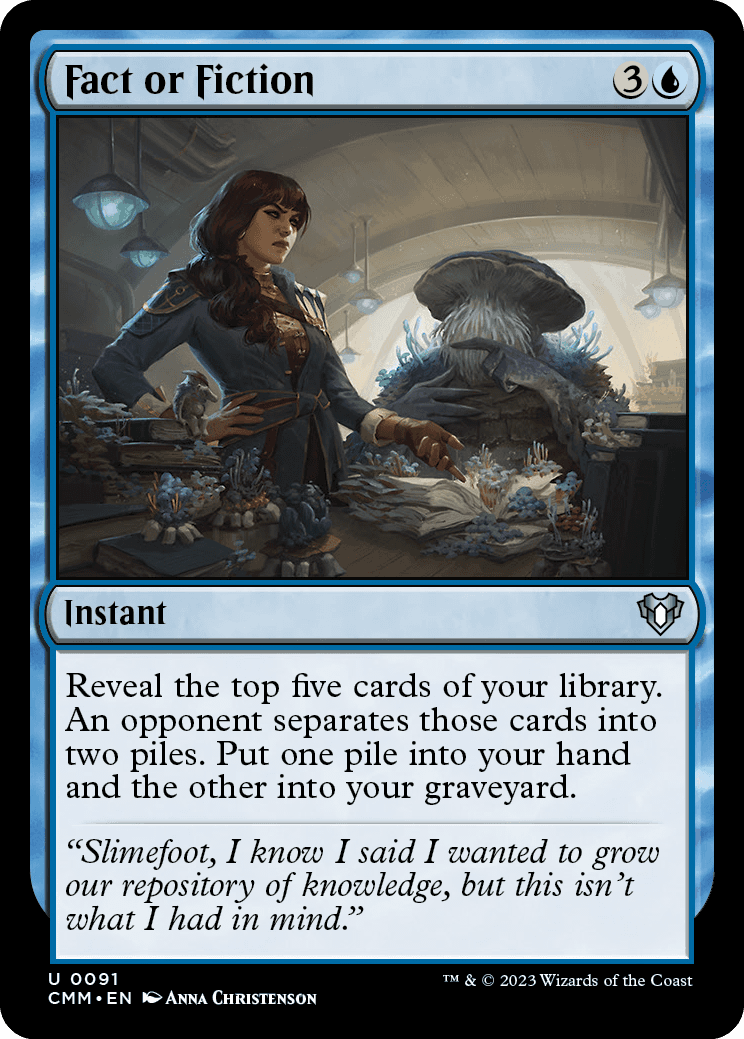

When I was initially hired into R&D, it was not as a designer but as a developer. I was upfront from the beginning that adjusting power level was not my area of expertise. I relied on other members to do that. Things imploded power-wise during Urza's Saga block, so much so that for the first and only time in my 28 years at Wizards, R&D was called before the CEO and chewed out.
I went to Bill, then head designer, and suggested that there was a great resource for finding new R&D members, specifically ones that could better judge power level. That source was the Pro Tour. I'd been involved with it since its beginning and was, at the time, attending them all. My first suggestion for an employee to hire was Randy Buehler. I'd gotten to know Randy from the Pro Tour and thought he'd be a good fit for R&D, and he was eventually hired.
The first set Randy worked on was Invasion as part of the development team. While I wasn't the lead of the development team, I was on the team, and I was constantly encouraging Randy to find spells that we could push that would lead to fun tournament play. The card he latched onto most was
One of the themes in Invasion was a mechanic we nicknamed "divvy." The way divvy worked was that one player would divide some number of cards into two piles, then the other player would choose one pile. Where the cards came from, what you did with them after, who made the piles, and who chose a pile—all of that varied from card to card.
The version that ended up being the coolest was the blue one that drew cards. Randy really liked it because the power level of the card was very dependent on the skill level of the two players. It was super Spike friendly. Also, at its worst, it was just a card-draw spell. Even if it was a little on the strong side, Randy felt the potential downside was curbed. The card wouldn't win games by itself, but it would let the more skilled player have an edge, and Randy thought that was great.
Hanna, Ship's Navigator
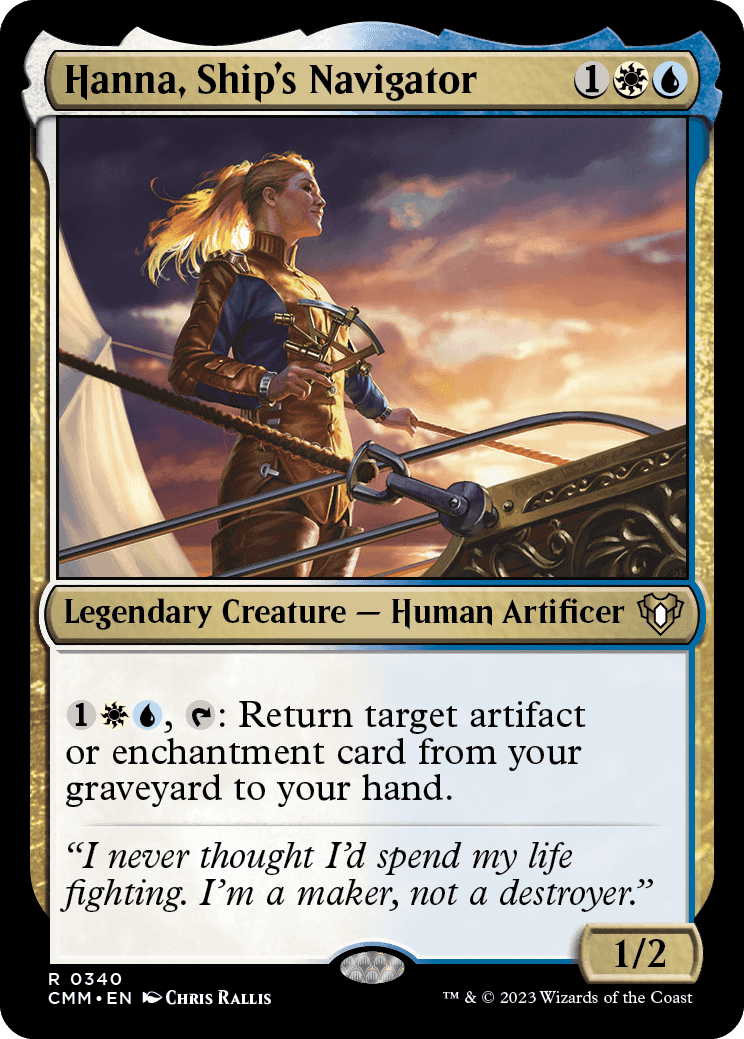
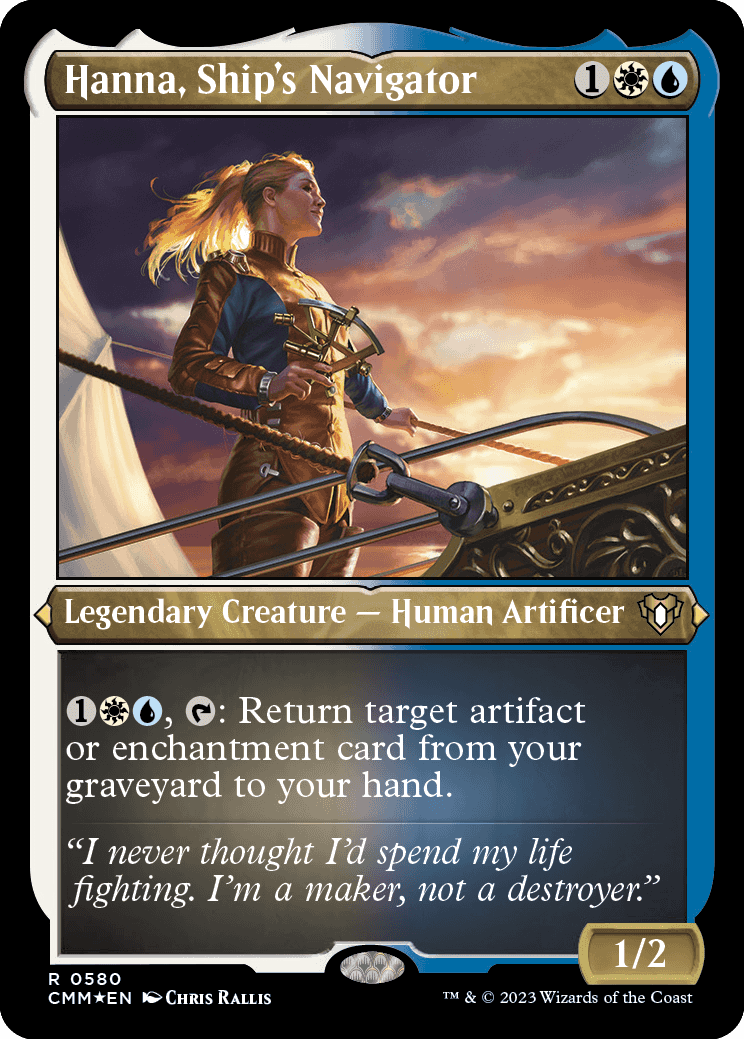
All Magic players have pet cards, and that includes the designers. The big difference about being a Magic designer is that you can use old favorites to inspire new designs.
Let's now go back to my time before working at Wizards. I was living in Los Angeles and was a Johnny who enjoyed making weird decks that won in strange and fun ways. One of my favorite tools was getting permanents back out of the graveyard. One-shot spells were okay, but I preferred having permanents that could do it repeatedly. I tended to enjoy designing decks that built up as the game progressed.
I was excited by
When The Dark came out, I had the same reaction to
Flash forward a couple of years. Michael Ryan and I pitched the Weatherlight Saga. I was careful to slowly dole out the crew members across sets. Finally, it was time to make a card for Hanna. She was the engineer of the crew, specializing in magical objects (much to her father
Hanna was a character that I had grown very fond of, and I wanted her to have a card that would excite players, so the idea of taking two pet cards that had meant so much to me and combining them into something better seemed like a golden opportunity. And that is how
Mikaeus, the Unhallowed
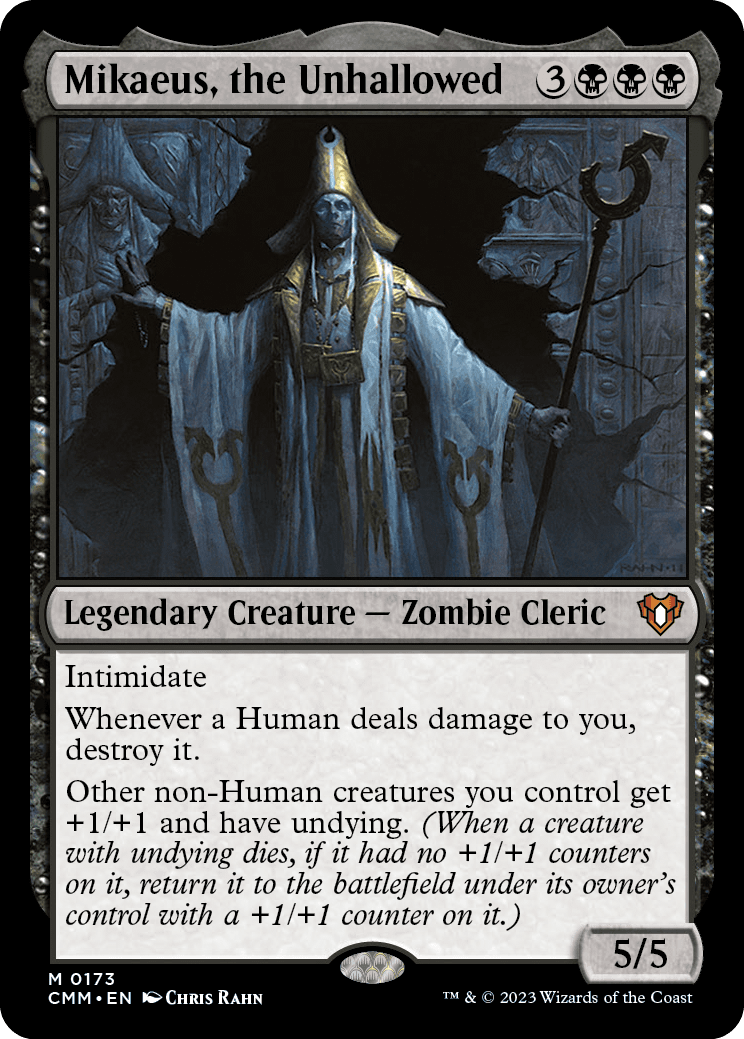
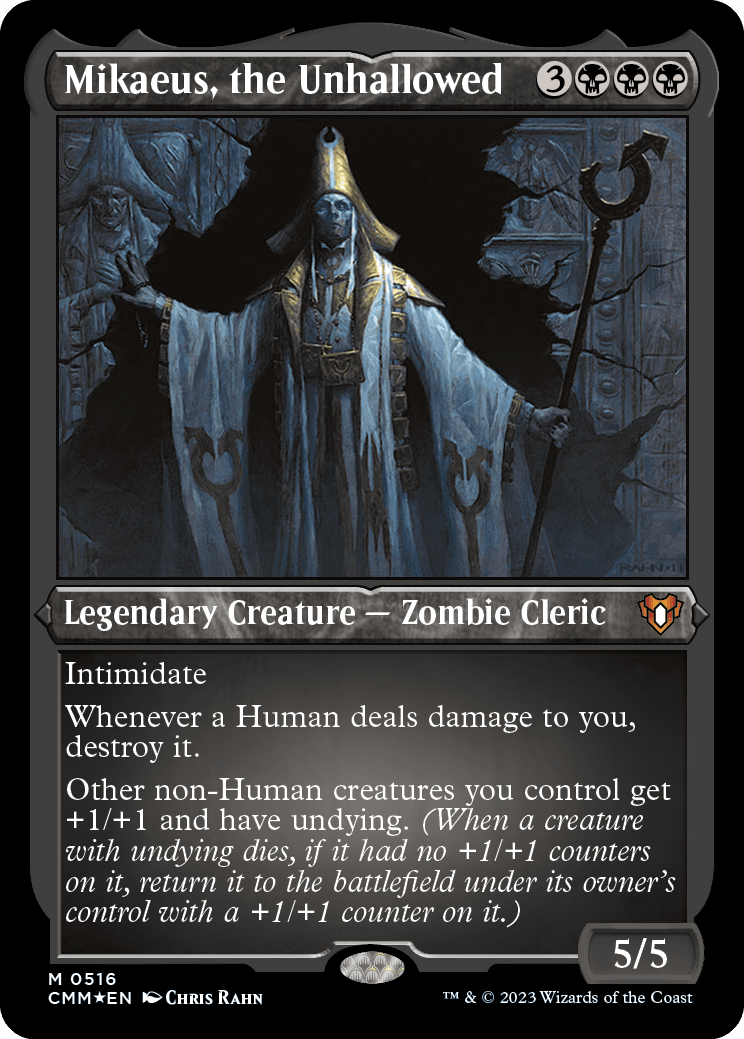
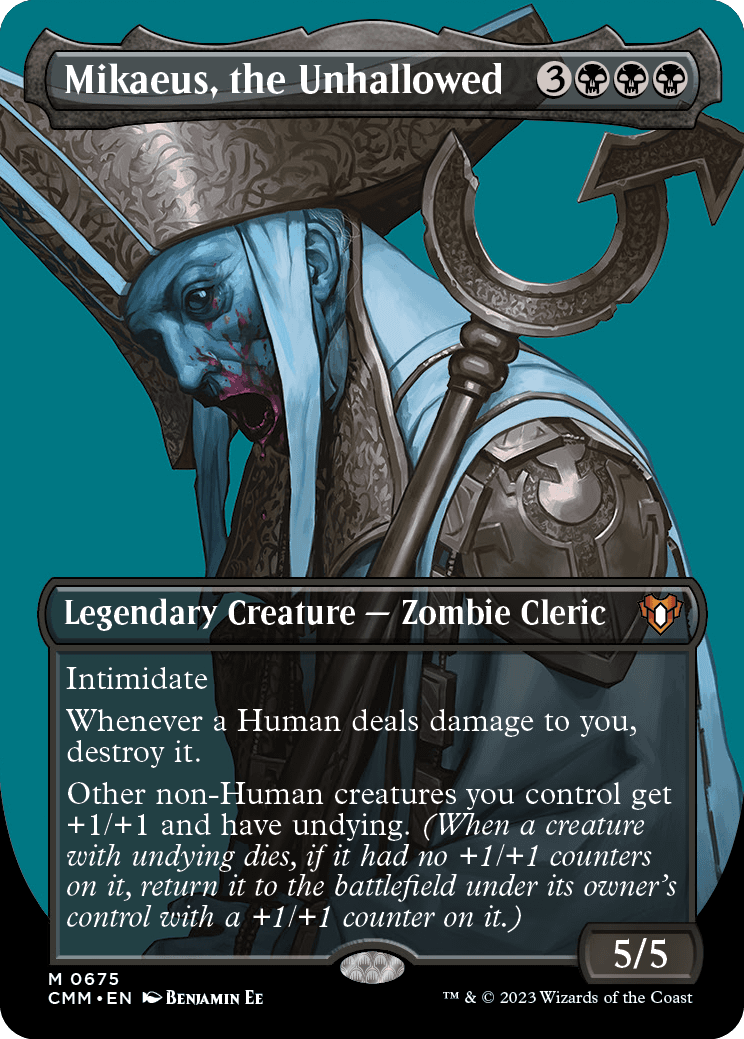
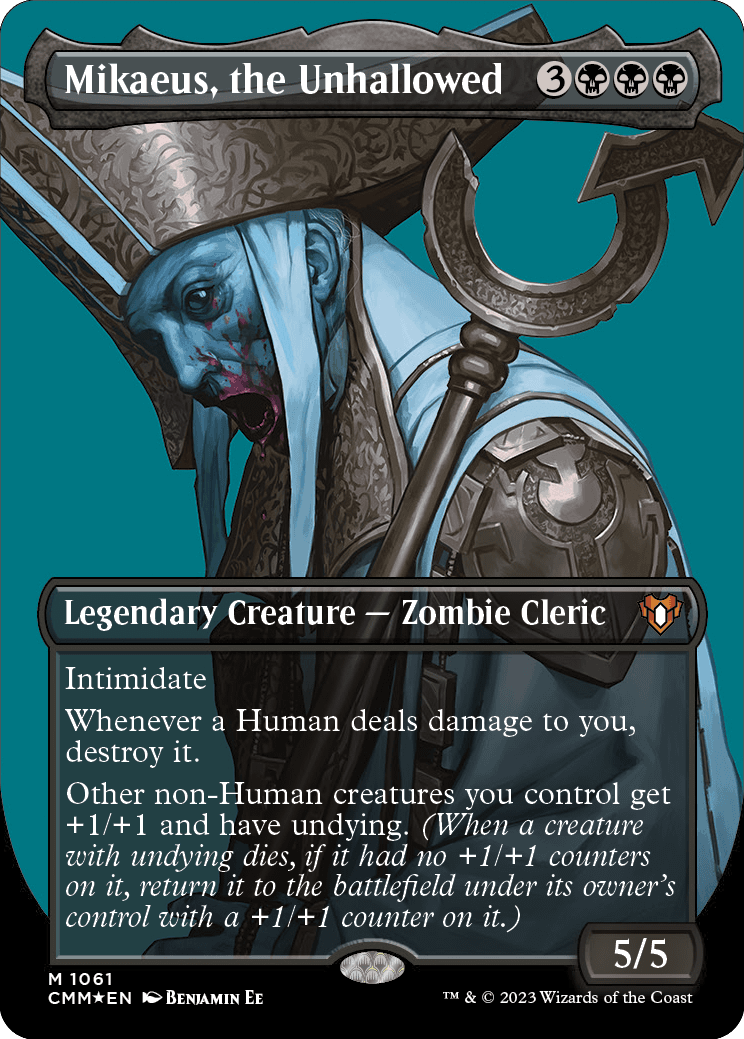
When Innistrad block design started, the story had only been loosely outlined. Here are my notes from the time:
"Shake" – Meet the monsters; humans are on brink of extinction.
"Rattle" – Things get worse for the humans.
As I mentioned in my section on Avacyn, the third set wasn't even set on Innistrad yet.
When planning blocks, I like to create some kind of progression in the cards. In Mirrodin block, we hinted at cards that hadn't been printed yet. In Ravnica block, we made ten-card cycles that we doled out a little each set. In Scars of Mirrodin, we watched a mechanic, infect, spread to new colors. What could we do in Innistrad block across multiple cards that could convey the plight of the humans? What could happen that would devastate the humans most?
Worldbuilding was in its early state, but the Creative team had come up with the idea of the humans having a religion that they leaned on for support. I don't believe Avacyn had even been created yet, as I think that was part of creating the event that justified staying on Innistrad but changing to new mechanics. Obviously, if there was a religion, there had to be a religious leader. What if we introduced him in Innistrad and then turned him into a monster in Dark Ascension? That seemed the perfect embodiment of the death of hope. Things have gotten so bad that the person they look to for guidance has fallen. I pitched the idea to the Creative team, and they liked it.
To show contrast, we made the Human
Then in Dark Ascension, it was time to make the Zombie version. We wanted some mechanical parallel between the two cards so they felt like the same character. The obvious choice was to have him now boost the monsters. Undying was the keyworded monster mechanic in the set, so we had him grant that and added an extra +1/+1 because players like that on creature lords (creatures that grant typal rewards).
It was important that the card felt specifically anti-Human to help play up the transformation into monster. We ended up using the ability from the card
"Storytime Is Over"
That's all the time I have for today. I hope you enjoyed my stories. If you have any feedback about today's column, any of the cards I talked about, or Commander Masters in general, you can email me or contact me through any of my social media accounts (Twitter, Tumblr, Instagram, and TikTok).
Join me next week for part two.
Until then, may you make stories of your own with these cards.

